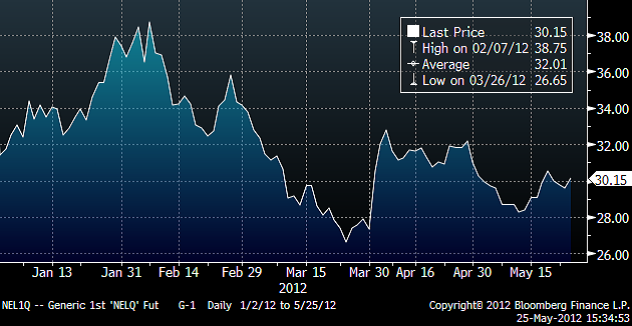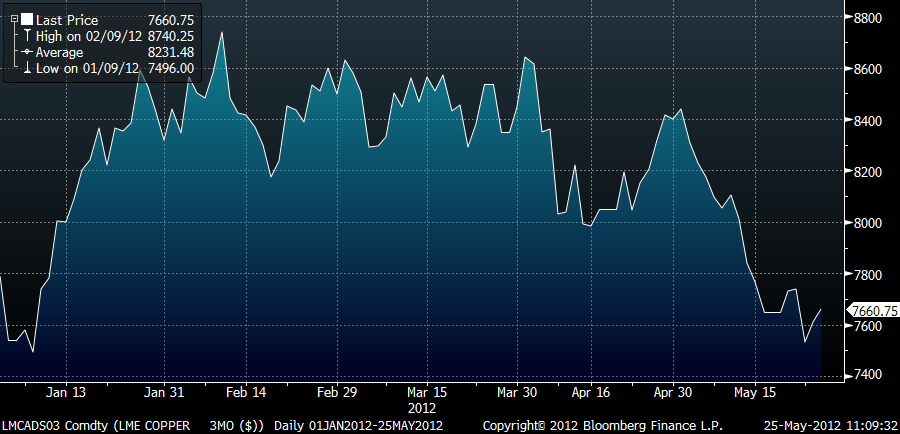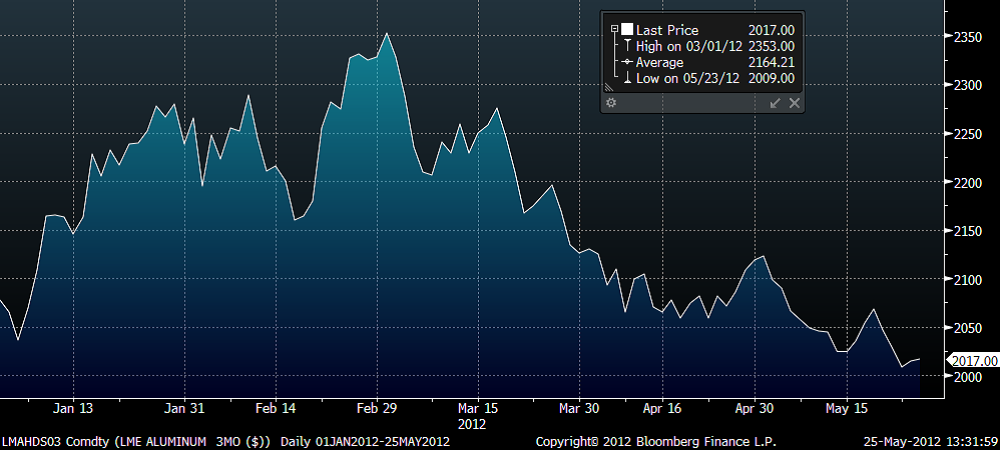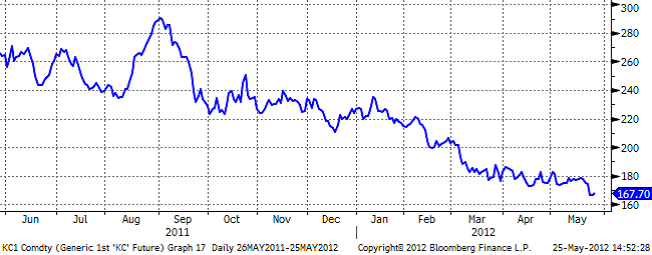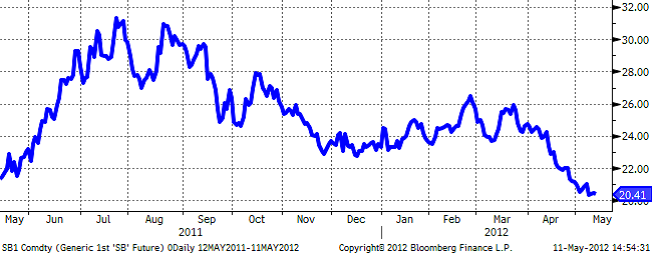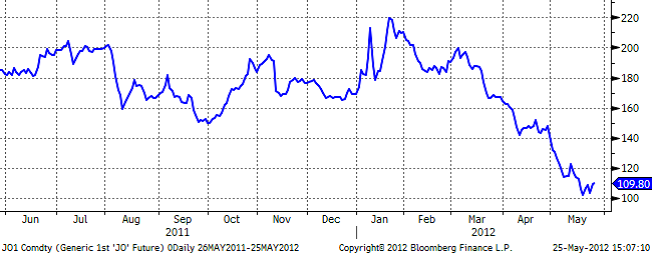Analys
SHB Råvarubrevet 25 maj 2012
 Marknaden har fortsatt att präglas av svalare riskaptit sedan förra veckobrevet. Råvaror tillsammans med börser och räntor har fallit. Oron för en grekisk närtida exit får sägas ha ökat, ratingnedgraderingarna har stått som spön i backen, spanska problemlån klättrar snabbt medan makrostatistiken inte gett några skäl till optimism. Kinadata har fortsatt att vara besvikelser med banken HSBCs preliminära inköpschefsindex för maj som senaste exempel. Vi tror på en kommande stark återhämtning för kinaexponerade råvaror – men inte ännu!
Marknaden har fortsatt att präglas av svalare riskaptit sedan förra veckobrevet. Råvaror tillsammans med börser och räntor har fallit. Oron för en grekisk närtida exit får sägas ha ökat, ratingnedgraderingarna har stått som spön i backen, spanska problemlån klättrar snabbt medan makrostatistiken inte gett några skäl till optimism. Kinadata har fortsatt att vara besvikelser med banken HSBCs preliminära inköpschefsindex för maj som senaste exempel. Vi tror på en kommande stark återhämtning för kinaexponerade råvaror – men inte ännu!
Parallellt med de negativa rubrikerna så har förväntansbilden skruvats ned kraftigt och det minskar risken för att makrodata blir besvikelser i närtid. När tillgångar har falligt med 10 – 15 % (OMX 30 och Brent) på mindre än två månader så brukar det komma en kort rekyl när köpintresset ökar igen.
Vi konstaterar att mycket dålig data kommit på kort tid och tryckt ner marknaden. Vi ser fortfarande flera nedåtrisker på 2 månaders sikt men tycker att detta kan vara ett intressant läge för den riskvillige att kortsiktigt söka avkastning i en annars dyster miljö. Vi favoriserar då mindre kinaexponerade råvaror som olja, som vi dessutom tycker har starkast fundamentalt stöd utav råvarorna.
Energi (neutral)
Olja
Oljemarknaden (Brent) som backade med ytterligare 3 procent ned till 105 dollar under inledningen av veckan återhämtar delar av rörelsen mot slutet vilket får ses som en korrektion. Fokus på Europa och lägre riskaptit för råvaror överlag men ser vi till det fundamentala lär även förbrukningsprognoser för den amerikanska marknaden skrivas ned något ytterligare inom den närmaste framtiden. En del stöd från amerikanska bensinlager som fortsatte ned och totalt nu fallit med 30 miljoner fat de senaste tre månaderna. Inga stora nyheter kring Iran där diskussionerna kring kärnvapenprogrammet flyttas fram till nästa månad. En nyhet om 300,000 fat mindre Iransk olja till marknaden med ett potentiellt scenario om 1 miljoner bortfall skulle tidigare givit ett ordentligt stöd åt köparna men i denna pessimistiska miljö påverkar det knappt alls. Trots en tekniskt väldigt översåld marknad verkar det fortsatt som risken finns på nedsidan på kort sikt.
Elmarknaden
Den försvagade energibalansen som bidrog till förra veckans uppgång genererade även inledningsvis av denna vecka en del köpintressen i marknaden. Överskottet om närmare 12 TWh har krympt till 6TWh på lite drygt en månad. Kvartalet Q3 2012 som är underliggande för SHB Power Index och våra sparprodukter handlas dock oförändrat efter att sentimentet försvagades något i mitten av veckan till följd av den allmänna utvecklingen på börserna. Mot slutet av veckan pekar prognoserna fortsatt på ett något torrare scenario där vi förväntas få mellan 2-4 TWh vilket därmed är något under normalen om 4.2 TWh för perioden. Denna högtrycksuppbyggnad och torra period har balanserats något av den svaga kolmarknaden där ett stort överskott och en stark dollar verkat negativt för kol och dämpa utvecklingen på el. En viss rekyl på både kol (där brytpriset för kolkraft stigit med ca 1 euro) och utsläppsrätter mot slutet av veckan men vi bedömer detta som tillfälligt och förväntar oss ingen vidare uppgång, snarare tvärtom.
Ser vi till den korta kurvan så är spotpriserna riktigt låga och väntas så vara även under nästa vecka. De höga temperaturerna gör att vattenproducenter har svårt att upprätthålla spotpriset på någon högre nivå till följd av den kraftiga snösmältningen. För att sammanfatta läget talar flera faktorer för att vi kommer att ligga kvar på dessa låga nivåer och om inte prognoserna slår om till betydligt torrare än de vi ser idag bör Q3 2012 kunna falla tillbaka någon euro under inledningen av nästa vecka.
Basmetaller (neutral)
Kopparpriset har pendlat upp och ner i pris under veckan för att stänga på ungefär oförändrat. Sedan årets början är priset ned ca 1.7 %. Koppar har den senaste tiden tagit stryk på grund av oron kring Grekland och världsekonomin. Som bekant anses metallen vara en ledande indikator för världskonjunkturen.
Kopparlagren från LME ökade för första gången på 7 veckor. Nyligen släppta produktionssiffror visar på att brytningen av koppar kommer överstiga efterfrågan redan i år och även 2014. I den andra vågskålen hittar vi siffror från världens största kopparproducent, chilenska Codelco. Företaget har producerat 10 % mindre koppar första kvartalet jämfört med första kvartalet 2011. Den främsta anledningen sägs vara minskade kopparhalter i malmen. Sammantaget är vi neutrala till kopparpriset.
Aluminiumpriset har under veckan gått ned med 2.4 %. Nedgången hittills i år är 2.8 %. Priset ligger i skrivande stund på 2 018 USD/ton. Ett flertal kunder har visst intresse att köpa strax över 2 000 USD-nivån. Cash-cost, det vill säga kostnaden för att få fram ett ton, ligger runt 1 900 enligt flera bedömare. Att kunna säkra in sin exponering på något över 2 000 har lockat in köparna.
Om vi försöker hitta positiva signaler kring världsekonomin så hittar vi det faktiskt i aluminiummarknaden. Leveranser till japanska förbrukare är upp för den tredje månaden i rad. Vi även snappat upp att importen av bauxit (råvaran till aluminium) till Kina har gått 49 % jämfört med förra året. Vi är neutrala till metaller och aluminium prismässigt, men tror att aluminium har bäst potential för prisuppgång på sikt.
Ädelmetaller
I slutet av förra veckan studsade guldet upp ganska ordentligt från nya årslägsta-nivåer, men denna veckan har vi sett det glida tillbaks med 2 %. Även övriga ädelmetaller har fallit i samma storleksordning, under en lugn vecka. Vi håller fast vår negativa syn på sektorn baserat på avsaknad av performance i den riskaverta miljö vi haft under senare tid.
Softs
Kaffe
Marknaden inväntar de brasilianska arabica skördarna vilka fortskrider något långsammare i år än tidigare år p.g.a. regn. Skördarna förväntas bli goda till följd av gynnsamma väderförhållanden under gångna säsongen men det råder fortsättningsvis en ovisshet beträffande landets kommande exportvolym då man ser en ökad inhemsk konsumtion. Efterfrågan på arabica kaffet har varit låg då flertalet köpare haft välfyllda lager inför skörden 2012/13.
Priset på arabica bönan har sjunkit drygt 20 % under 2012 inväntandes 2011/12 skörden vi nu står inför, kaffekonsumtionen förväntas öka globalt de kommande åren och skörden 2013-14 benämns som ett ”off” år i arabicakaffets skördecykler (högre/lägre skörd vartannat år).
Socker
Socker handlades upp något i början av veckan till följd av det något torrare vädret i Brasilien och därmed risk för sämre skördar. Även en något ökad efterfrågan och rapporter om ökat antal lastfartyg vid de brasilianska hamnarna redo för lastning av råvaran fick priset att stiga. Det ekonomiska läget i Europa fick priset på socker att sjunka igen mot mitten av veckan och handlas fortsättningsvis lågt. Marknaden är något avvaktande inför brasilianska skördeperioden som inleds om bara några veckor, och inväntar även handeln inför ramadan som hittills varit modest. Ramadan inleds i juli och de muslimska länderna brukar fylla sina lager innan dess. Indien som förra veckan beslöt att tillåta obegränsad export av socker har inte publicerat sin planerade exportvolym. Indiens skördar är goda i år och det socker de inte exporterar i år har de möjlighet att lagra för export nästa år, vilket i sin tur kan påverka priset på sikt.
Apelsinjuice
Priset på apelsinjuice fortsätter på sin låga nivå till följd av ökat utbud och den rådande ekonomiska situationen i Europa håller efterfrågan på fortsatt låga nivåer. Väderförhållandena har varit gynnsamma och skördarna är goda. Florida närmar sig orkansäsongen och antalet namngivna orkaner motsvarar tidigare år även om man i år inväntar orkaner något tidigare på säsongen. Även om säsongens tidiga orkaner i sig inte verkar utgöra något större hot för skörden påminner de marknaden om risken och tillfälliga uppgångar i priset har setts. Brasiliens Real har tappat 5,5 % mot USD sedan jan 2012.
Handelsbankens Råvaruindex
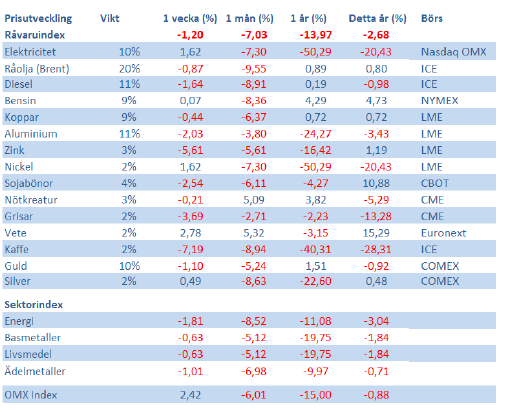 Handelsbankens råvaruindex består av de underliggande indexen för respektive råvara. Vikterna är bestämda till hälften från värdet av global produktion och till hälften från likviditeten i terminskontrakten.
Handelsbankens råvaruindex består av de underliggande indexen för respektive råvara. Vikterna är bestämda till hälften från värdet av global produktion och till hälften från likviditeten i terminskontrakten.
[box]SHB Råvarubrevet är producerat av Handelsbanken och publiceras i samarbete och med tillstånd på Råvarumarknaden.se[/box]
Ansvarsbegränsning
Detta material är producerat av Svenska Handelsbanken AB (publ) i fortsättningen kallad Handelsbanken. De som arbetar med innehållet är inte analytiker och materialet är inte oberoende investeringsanalys. Innehållet är uteslutande avsett för kunder i Sverige. Syftet är att ge en allmän information till Handelsbankens kunder och utgör inte ett personligt investeringsråd eller en personlig rekommendation. Informationen ska inte ensamt utgöra underlag för investeringsbeslut. Kunder bör inhämta råd från sina rådgivare och basera sina investeringsbeslut utifrån egen erfarenhet.
Informationen i materialet kan ändras och också avvika från de åsikter som uttrycks i oberoende investeringsanalyser från Handelsbanken. Informationen grundar sig på allmänt tillgänglig information och är hämtad från källor som bedöms som tillförlitliga, men riktigheten kan inte garanteras och informationen kan vara ofullständig eller nedkortad. Ingen del av förslaget får reproduceras eller distribueras till någon annan person utan att Handelsbanken dessförinnan lämnat sitt skriftliga medgivande. Handelsbanken ansvarar inte för att materialet används på ett sätt som strider mot förbudet mot vidarebefordran eller offentliggörs i strid med bankens regler.
Analys
Tightening fundamentals – bullish inventories from DOE

The latest weekly report from the US DOE showed a substantial drawdown across key petroleum categories, adding more upside potential to the fundamental picture.

Commercial crude inventories (excl. SPR) fell by 5.8 million barrels, bringing total inventories down to 415.1 million barrels. Now sitting 11% below the five-year seasonal norm and placed in the lowest 2015-2022 range (see picture below).
Product inventories also tightened further last week. Gasoline inventories declined by 2.1 million barrels, with reductions seen in both finished gasoline and blending components. Current gasoline levels are about 3% below the five-year average for this time of year.
Among products, the most notable move came in diesel, where inventories dropped by almost 4.1 million barrels, deepening the deficit to around 20% below seasonal norms – continuing to underscore the persistent supply tightness in diesel markets.
The only area of inventory growth was in propane/propylene, which posted a significant 5.1-million-barrel build and now stands 9% above the five-year average.
Total commercial petroleum inventories (crude plus refined products) declined by 4.2 million barrels on the week, reinforcing the overall tightening of US crude and products.


Analys
Bombs to ”ceasefire” in hours – Brent below $70

A classic case of “buy the rumor, sell the news” played out in oil markets, as Brent crude has dropped sharply – down nearly USD 10 per barrel since yesterday evening – following Iran’s retaliatory strike on a U.S. air base in Qatar. The immediate reaction was: “That was it?” The strike followed a carefully calibrated, non-escalatory playbook, avoiding direct threats to energy infrastructure or disruption of shipping through the Strait of Hormuz – thus calming worst-case fears.

After Monday morning’s sharp spike to USD 81.4 per barrel, triggered by the U.S. bombing of Iranian nuclear facilities, oil prices drifted sideways in anticipation of a potential Iranian response. That response came with advance warning and caused limited physical damage. Early this morning, both the U.S. President and Iranian state media announced a ceasefire, effectively placing a lid on the immediate conflict risk – at least for now.
As a result, Brent crude has now fallen by a total of USD 12 from Monday’s peak, currently trading around USD 69 per barrel.
Looking beyond geopolitics, the market will now shift its focus to the upcoming OPEC+ meeting in early July. Saudi Arabia’s decision to increase output earlier this year – despite falling prices – has drawn renewed attention considering recent developments. Some suggest this was a response to U.S. pressure to offset potential Iranian supply losses.
However, consensus is that the move was driven more by internal OPEC+ dynamics. After years of curbing production to support prices, Riyadh had grown frustrated with quota-busting by several members (notably Kazakhstan). With Saudi Arabia cutting up to 2 million barrels per day – roughly 2% of global supply – returns were diminishing, and the risk of losing market share was rising. The production increase is widely seen as an effort to reassert leadership and restore discipline within the group.
That said, the FT recently stated that, the Saudis remain wary of past missteps. In 2018, Riyadh ramped up output at Trump’s request ahead of Iran sanctions, only to see prices collapse when the U.S. granted broad waivers – triggering oversupply. Officials have reportedly made it clear they don’t intend to repeat that mistake.
The recent visit by President Trump to Saudi Arabia, which included agreements on AI, defense, and nuclear cooperation, suggests a broader strategic alignment. This has fueled speculation about a quiet “pump-for-politics” deal behind recent production moves.
Looking ahead, oil prices have now retraced the entire rally sparked by the June 13 Israel–Iran escalation. This retreat provides more political and policy space for both the U.S. and Saudi Arabia. Specifically, it makes it easier for Riyadh to scale back its three recent production hikes of 411,000 barrels each, potentially returning to more moderate increases of 137,000 barrels for August and September.
In short: with no major loss of Iranian supply to the market, OPEC+ – led by Saudi Arabia – no longer needs to compensate for a disruption that hasn’t materialized, especially not to please the U.S. at the cost of its own market strategy. As the Saudis themselves have signaled, they are unlikely to repeat previous mistakes.
Conclusion: With Brent now in the high USD 60s, buying oil looks fundamentally justified. The geopolitical premium has deflated, but tensions between Israel and Iran remain unresolved – and the risk of missteps and renewed escalation still lingers. In fact, even this morning, reports have emerged of renewed missile fire despite the declared “truce.” The path forward may be calmer – but it is far from stable.
Analys
A muted price reaction. Market looks relaxed, but it is still on edge waiting for what Iran will do

Brent crossed the 80-line this morning but quickly fell back assigning limited probability for Iran choosing to close the Strait of Hormuz. Brent traded in a range of USD 70.56 – 79.04/b last week as the market fluctuated between ”Iran wants a deal” and ”US is about to attack Iran”. At the end of the week though, Donald Trump managed to convince markets (and probably also Iran) that he would make a decision within two weeks. I.e. no imminent attack. Previously when when he has talked about ”making a decision within two weeks” he has often ended up doing nothing in the end. The oil market relaxed as a result and the week ended at USD 77.01/b which is just USD 6/b above the year to date average of USD 71/b.

Brent jumped to USD 81.4/b this morning, the highest since mid-January, but then quickly fell back to a current price of USD 78.2/b which is only up 1.5% versus the close on Friday. As such the market is pricing a fairly low probability that Iran will actually close the Strait of Hormuz. Probably because it will hurt Iranian oil exports as well as the global oil market.
It was however all smoke and mirrors. Deception. The US attacked Iran on Saturday. The attack involved 125 warplanes, submarines and surface warships and 14 bunker buster bombs were dropped on Iranian nuclear sites including Fordow, Natanz and Isfahan. In response the Iranian Parliament voted in support of closing the Strait of Hormuz where some 17 mb of crude and products is transported to the global market every day plus significant volumes of LNG. This is however merely an advise to the Supreme leader Ayatollah Ali Khamenei and the Supreme National Security Council which sits with the final and actual decision.
No supply of oil is lost yet. It is about the risk of Iran closing the Strait of Hormuz or not. So far not a single drop of oil supply has been lost to the global market. The price at the moment is all about the assessed risk of loss of supply. Will Iran choose to choke of the Strait of Hormuz or not? That is the big question. It would be painful for US consumers, for Donald Trump’s voter base, for the global economy but also for Iran and its population which relies on oil exports and income from selling oil out of that Strait as well. As such it is not a no-brainer choice for Iran to close the Strait for oil exports. And looking at the il price this morning it is clear that the oil market doesn’t assign a very high probability of it happening. It is however probably well within the capability of Iran to close the Strait off with rockets, mines, air-drones and possibly sea-drones. Just look at how Ukraine has been able to control and damage the Russian Black Sea fleet.
What to do about the highly enriched uranium which has gone missing? While the US and Israel can celebrate their destruction of Iranian nuclear facilities they are also scratching their heads over what to do with the lost Iranian nuclear material. Iran had 408 kg of highly enriched uranium (IAEA). Almost weapons grade. Enough for some 10 nuclear warheads. It seems to have been transported out of Fordow before the attack this weekend.
The market is still on edge. USD 80-something/b seems sensible while we wait. The oil market reaction to this weekend’s events is very muted so far. The market is still on edge awaiting what Iran will do. Because Iran will do something. But what and when? An oil price of 80-something seems like a sensible level until something do happen.
-

 Nyheter3 veckor sedan
Nyheter3 veckor sedanStor uppsida i Lappland Guldprospekterings aktie enligt analys
-

 Nyheter4 veckor sedan
Nyheter4 veckor sedanBrookfield ska bygga ett AI-datacenter på hela 750 MW i Strängnäs
-

 Nyheter3 veckor sedan
Nyheter3 veckor sedanSilverpriset släpar efter guldets utveckling, har mer uppsida
-

 Nyheter4 veckor sedan
Nyheter4 veckor sedanTradingfirman XTX Markets bygger datacenter i finska Kajana för 1 miljard euro
-

 Nyheter2 veckor sedan
Nyheter2 veckor sedanUppgången i oljepriset planade ut under helgen
-

 Nyheter2 veckor sedan
Nyheter2 veckor sedanLåga elpriser i sommar – men mellersta Sverige får en ökning
-

 Analys2 veckor sedan
Analys2 veckor sedanVery relaxed at USD 75/b. Risk barometer will likely fluctuate to higher levels with Brent into the 80ies or higher coming 2-3 weeks
-

 Nyheter1 vecka sedan
Nyheter1 vecka sedanMahvie Minerals växlar spår – satsar fullt ut på guld


